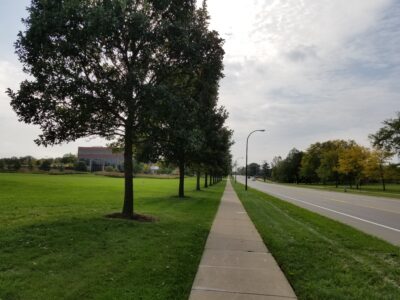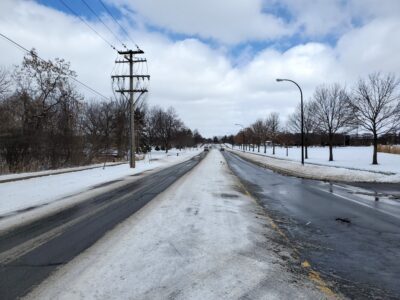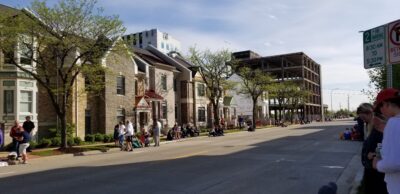Down the street from the League’s Ann Arbor offices is this row of oak trees, 20 years old or so. They line the vacant lot, about a five-acre grassy space, at the edge of an office park.
I do not like these trees.

The offending trees.
It’s nothing personal—they are very nice trees, and have done nothing wrong—but they bother me every time I walk past them because they were planted in the wrong place.
Most likely, when the first phases of the office park were developed, the city’s zoning ordinance required that these trees be planted around the edge of the site as a “green buffer” for the development, a common standard based on the theory that development is ugly and passerby need to be protected from it by a moat of plants. As in this case, these well-intended requirements can be counter-productive: by looking narrowly at the site, the development standards misuse good trees as mere damage control, when they could have been the seeds of a great place.
Imagine if they had been planted as street trees, between the sidewalk and the curb, instead of ten feet behind the curb. At this point, they’d be shading a good portion of the pavement, and in another few decades might reach over the centerline—perhaps meeting trees planted on the other side of the street. This wide-open suburban byway, where drivers regularly drive 10 over the speed limit, would feel much more like a city street, with all of the safety, cooling, stormwater, and health benefits that properly placed street trees provide.

Our trees could be used for so much better than merely dressing up the edges of these parking lots.
Next there’s the impact the trees have on the future development of that parcel. This site is a short bus ride from downtown Ann Arbor and the University of Michigan’s campus and medical center, plus has two supermarkets, a drugstore, coffee shop, and several restaurants clustered around the nearby intersection at Plymouth Road. If the trees were in their proper location as street trees, we could easily imagine a neighborhood of townhomes at this location, opening the fierce Ann Arbor housing market to 100 or so more households. With front stoops near the sidewalk, parking limited and accessed from alleys in the rear, such a neighborhood would continue transforming the area.
But where the trees are now, 10 feet behind the sidewalk, they push any future development of the site back away from the street, encouraging a continuation of the car-centric suburban pattern. We only have to look at the site next door to see what kind of development these trees support: stormwater basin, parking lot, standalone office building, more parking lot.
Streets reflect the use of the land around them. The road sees traffic levels of 3,900 vehicles / day, in SEMCOG’s most recent counts. As a general rule of thumb, a street can carry about 10,000 vehicles a day with a single lane in each direction. The three-lane layout of this road is wildly overbuilt, especially considering how few places there are to make a left turn: it only makes sense because there’s nothing better to do with the width.

Low traffic volume and few intersections means the left turn lane isn’t even considered worth plowing–which creates a hazard for pedestrians at crosswalks.
In our scenario of street trees and townhomes, though, Green Road cries out to be a better street—to put that space to better use. Let’s eliminate that completely unnecessary left turn lane, then put a row of on-street parking along the front of our townhomes on the east side of the street. Bike lanes along parking lanes are dangerous, so let’s use the remaining width for a two-way protected cycle track on the west side of the street, creating a safer connection between the neighborhoods to the south, the commercial amenities at Plymouth Road to the north, and the campus access points to the west.
We could continue rippling outwards to see how these changes support even more momentum towards creating great human habitat, rather than moving cars at unnecessary speeds, but you get the point: the trees are in the wrong place.
(Spoiler alert: later this year we’ll be rolling out the second Michigan-specific “Enabling Better Places” guide as part of the Project for Code Reform. This guide will focus on incremental tactics for updating local zoning codes to enable, not necessarily guarantee, development that supports great places in suburban corridors. As a hater of trees-in-wrong-places, I’m pleased to note the draft has “eliminate buffer requirements” on page 29.)

This street in Muskegon shows how a street with the same width of pavement can have an entirely different feel when that width is allocated differently and the adjacent land use is oriented at people over cars.